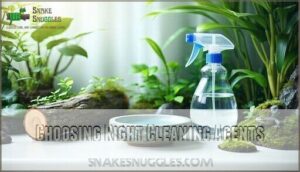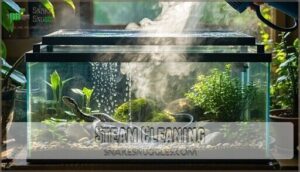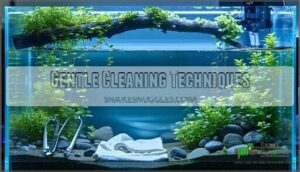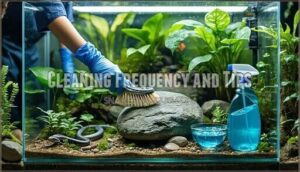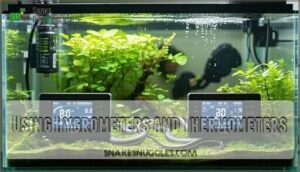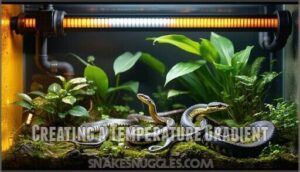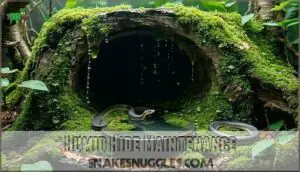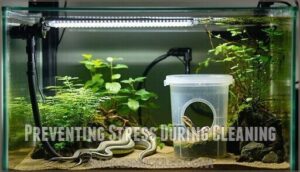This site is supported by our readers. We may earn a commission, at no cost to you, if you purchase through links.
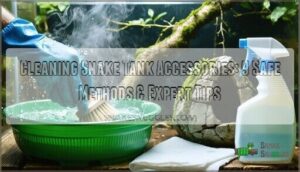
You’ll want to remove accessories weekly, scrub with appropriate cleaning agents, and rinse thoroughly before air-drying.
Steam cleaning works effectively for non-porous items, while vinegar solutions handle mineral deposits.
Never use household cleaners containing ammonia or bleach – they’re toxic to reptiles.
Focus on water dishes, hiding spots, and climbing structures since these harbor the most pathogens.
Quick daily spot-cleaning prevents bacterial buildup that can cause respiratory infections within 48-72 hours.
The specific cleaning method depends on your accessory material and your snake’s species requirements.
Table Of Contents
- Key Takeaways
- Cleaning Snake Tank Accessories
- Choosing Right Cleaning Agents
- Safe Cleaning Methods
- Top 9 Snake Tank Accessories
- 1. Reptile Terrarium Plants Hanging Vines
- 2. Large Reptile Corner Water Dish
- 3. Snake Climbing Toy Reptile Habitat
- 4. Sukh Reptile Sphagnum Moss Bedding
- 5. Aquarium Tweezers Long Stainless Steel Set
- 6. Natural Coral Driftwood Aquarium Decor
- 7. Snake Climbing Enrichment Toy for Reptiles
- 8. Mini Digital Hygrometer Thermometer 2 Pack
- 9. Snake Climbing Rings Reptile Enrichment
- Cleaning Frequency and Tips
- Maintaining Humidity and Temperature
- Preventing Stress During Cleaning
- Common Mistakes to Avoid
- Frequently Asked Questions (FAQs)
- How to clean snake enclosure accessories?
- What is the best cleaner for snake tanks?
- How often should you clean a snake tank?
- How often should water dishes be replaced?
- Can I use dish soap on accessories?
- What temperature kills harmful bacteria and parasites?
- Should I clean accessories while snake watches?
- How long should disinfectants sit before rinsing?
- Conclusion
Key Takeaways
- Use veterinary-grade disinfectants like F10SC or chlorhexidine solutions instead of household cleaners – they’ll eliminate harmful bacteria without creating toxic fumes that can cause respiratory problems in your snake.
- Clean water dishes and hiding spots weekly since they harbor the most dangerous pathogens – daily spot-cleaning prevents bacterial buildup that can cause infections within 48-72 hours.
- Steam clean non-porous accessories at temperatures above 200°F to kill pathogens without chemicals, and always rinse thoroughly after using any disinfectant before returning items to your snake’s enclosure.
- Remove your snake to temporary housing during cleaning to minimize stress, and never use ammonia-based products or bleach as they’re toxic to reptiles and can cause serious health issues.
Cleaning Snake Tank Accessories
Maintaining clean snake tank accessories prevents dangerous bacterial and fungal infections that can cause lethargy, appetite loss, and skin problems in your reptile.
You’ll need the right disinfectants and gentle techniques to create a safe environment without stressing your snake during the cleaning process.
Importance of Regular Cleaning
Regular cleaning of snake tank accessories prevents dangerous bacterial and fungal infections that threaten your reptile’s health.
Without proper hygiene standards, pathogens multiply rapidly in warm, humid environments.
This creates serious health implications including respiratory infections, scale rot, and weakened immunity.
Consistent reptile accessories maintenance guarantees infection prevention while supporting your snake’s behavioral impacts and overall well-being benefits through reptile accessories disinfection protocols.
Preventing Bacterial and Fungal Infections
Why do unclean reptile accessories become breeding grounds for dangerous pathogens?
Reptile bacteria and reptile fungi thrive in dirty environments, causing lethargy, appetite loss, and skin discoloration. Infection symptoms develop rapidly without proper hygiene practices.
Safe enclosures require consistent reptile accessories cleaning using effective reptile disinfection methods. A monthly deep clean is also essential for maintaining a healthy environment.
Proactive measures prevent costly vet visits through early detection of contamination. Regular reptile infections prevention protects your snake’s health and immunity.
Choosing Right Cleaning Agents
You’ll need safe, effective cleaning agents that won’t harm your snake or compromise their habitat’s delicate environment.
The right disinfectant eliminates harmful pathogens while ensuring your snake’s respiratory system stays healthy after the enclosure dries completely.
F10SC Veterinary Disinfectant
After understanding why cleaning matters, let’s talk F10SC Veterinary Disinfectant.
With proven broad-spectrum efficacy, it takes on bacteria, viruses, and fungi—perfect for snake tank disinfection.
Use the right F10SC dilution for a reptile-safe disinfectant solution. No need to rinse; safe drying means less hassle.
It’s the go-to reptile tank cleaner for cleaning reptile accessories and maintaining fungal control.
It’s also effective as a cold sterilisation method for instruments.
Chlorhexidine
Chlorhexidine offers broad spectrum antimicrobial action against bacteria and fungi in reptile environments.
Use a 1:32 chlorhexidine dilution for safe application when you disinfect snake tank accessories.
This veterinary-grade solution provides reptile safety without toxic residues after surfaces dry completely.
This powerful disinfectant is commonly recommended for reptile care.
Apply with spray bottles, allow five-minute contact time, then rinse thoroughly.
Always verify residue removal before returning your snake to clean snake accessories for superior reptile cleaning results.
Vinegar and Water Solution
You’ll find vinegar and water solution serves as your budget-friendly cleaning option for snake tank accessories.
This mild disinfectant works best on glass and plastic surfaces but won’t eliminate all pathogens like specialized reptile cleaning products can.
- Mix equal parts white vinegar and water for ideal vinegar dilution ratios
- Test material compatibility on small areas first to prevent damage
- Rinse thoroughly after cleaning to guarantee complete residue removal
- Recognize cleaning limitations – vinegar won’t kill cryptosporidium or tough bacteria
Safe Cleaning Methods
Steam cleaning at temperatures above 200°F kills most pathogens without chemicals, making it perfect for non-porous accessories like ceramic hides and water dishes.
You’ll want to combine this with gentle techniques like soaking in diluted F10SC and avoiding toxic substances like ammonia-based cleaners that stress your snake.
Steam Cleaning
Steam cleaning offers pathogen elimination through temperatures reaching 248°F, killing 97-100% of microorganisms on snake tank accessories.
This temperature control method provides safe application without chemical residue concerns for reptile habitat cleaning.
You’ll achieve effective cleaning reptile decor while maintaining material compatibility with glass and metal surfaces during snake tank accessories cleaning.
| Surface Type | Steam Temperature | Contact Time |
|---|---|---|
| Glass/Metal | 248°F (120°C) | 30 seconds |
| Sealed Wood | 200°F (93°C) | 45 seconds |
| Hard Plastic | 180°F (82°C) | 60 seconds |
Gentle Cleaning Techniques
Handling snake tank accessories requires finesse. You’ll want to minimize stress during cleaning by making gradual changes to their environment. Your snake notices everything, so gentle movements matter more than you’d think.
Here’s your gentle cleaning approach:
- Use handling alternatives like tongs or clean gloves when moving reptile accessories cleaning items
- Practice safe relocation by removing your snake to a secure temporary container first
- Focus on observing behavior – stressed snakes often refuse food or hide excessively
Remember that reptile accessories bacteria builds up slowly, so consistent gentle maintenance beats aggressive deep cleaning that disrupts your snake’s comfort zone.
Avoiding Toxic Substances
When cleaning snake habitats, toxic substances pose serious threats you can’t ignore.
Never use ammonia-based products or strongly scented cleaners – they’ll stress your snake and potentially cause respiratory issues.
Always rinse thoroughly after using any disinfectant, ensuring complete residue removal.
Proper ventilation importance can’t be overstated when using commercial products.
DIY cleaner safety matters too; even natural solutions require complete rinsing for nontoxic results.
Top 9 Snake Tank Accessories
You’ll need the right accessories to create a healthy snake environment, but keeping them clean is equally important for your pet’s wellbeing.
These nine essential accessories require specific cleaning methods to maintain proper hygiene while preserving their functionality and safety.
1. Reptile Terrarium Plants Hanging Vines
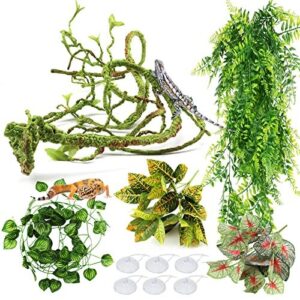
These colorful artificial vines transform sterile tanks into jungle-like retreats your snake will appreciate.
They are made from non-toxic plastic with bendable wire cores, they’re perfect for arboreal species seeking elevated hideouts.
Clean them weekly using warm water and gentle scrubbing to prevent bacterial buildup.
For deep disinfection, soak in diluted bleach solution for fifteen minutes, then rinse thoroughly until no chemical odor remains.
Replace damaged vines immediately since tears harbor stubborn pathogens, and maintain the cleanliness of the environment to ensure the health of your snake, which will appreciate the jungle-like retreats.
Best For: Arboreal reptile owners seeking low-maintenance jungle-like habitat enrichment for species like chameleons, geckos, and tree frogs.
- Non-toxic materials with bendable wire cores allow safe customization and repositioning for different enclosure layouts
- Maintenance-free artificial plants require no light or water while providing realistic climbing surfaces and humidity retention
- Easy weekly cleaning with warm water and thorough disinfection options using diluted bleach solutions
- Strong chemical odor upon opening requires soaking and cleaning before safe use in reptile enclosures
- Suction cups may not adhere reliably to all terrarium surfaces, potentially requiring alternative mounting methods
- Wire cores may not support heavier reptiles and foam surfaces can tear with excessive bending or handling
2. Large Reptile Corner Water Dish
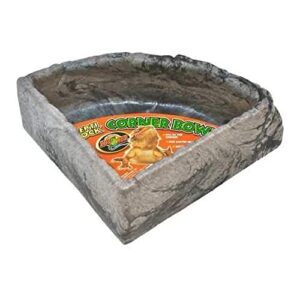
Your reptile’s hydration station deserves careful attention.
This 9"L x 9"W x 3"H corner dish holds over a gallon of water while fitting snugly into tank corners.
Daily cleaning prevents bacterial buildup that threatens snake health.
Rinse with warm water and refill fresh daily.
Weekly deep cleaning using F10SC disinfectant (1:250 dilution) or chlorhexidine eliminates harmful pathogens.
The non-porous plastic surface resists contamination but requires thorough rinsing after chemical treatment.
Multiple dishes allow rotation while others dry completely.
Consider the bowl’s placement for proper thermoregulation to ensure a healthy environment for your reptile, and remember that daily cleaning is essential for their well-being.
Best For: Snake owners, bearded dragon keepers, and other reptile enthusiasts who need a spacious, easy-to-clean corner water dish for medium to large reptiles.
- Size may be inappropriate for some reptiles – Large might be too small, Extra Large too big
- Daily cleaning required to prevent harmful bacterial growth like E. coli and salmonella
- Plastic material accumulates more bacteria over time compared to ceramic or resin alternatives
- Holds over a gallon of water while maximizing tank space with corner-fitting design
- Durable, non-porous plastic surface resists bacterial buildup and cleans easily
- Versatile use as water dish, soaking station, or dig box with substrate
3. Snake Climbing Toy Reptile Habitat
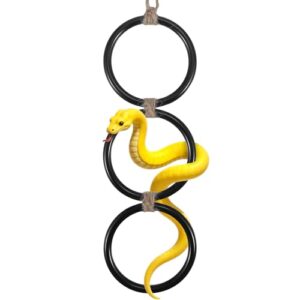
When you’re setting up climbing enrichment, this lightweight PP material accessory transforms your snake’s world into a vertical playground.
The 17.1 x 3.5-inch textured surface mimics natural bark, encouraging your ball python or corn snake to exercise those climbing instincts.
You’ll love how the shatter-resistant black design holds up to weekly scrubbing with dish soap and hot water.
For deep cleaning, soak it in 10% bleach solution for 30 minutes, then rinse thoroughly. The irregular shape creates multiple grip points while staying cool under moderate heat sources.
Best For: Snake owners seeking durable climbing enrichment that promotes natural behaviors in ball pythons, corn snakes, and other climbing reptile species.
- Shatter-resistant PP construction withstands regular cleaning and reptile activity
- Textured surface mimics natural bark to encourage climbing instincts and physical exercise
- Lightweight design allows easy repositioning and installation without tools
- Indoor use only limits versatility compared to outdoor-rated alternatives
- Black color may show dust and debris more readily than lighter alternatives
- Manual measurement variations mean actual dimensions may differ slightly from specifications
4. Sukh Reptile Sphagnum Moss Bedding
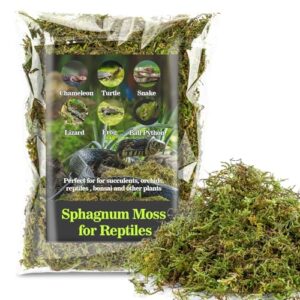
Within your snake’s habitat, sphagnum moss bedding serves as both substrate and humidity controller.
This natural material absorbs water like a sponge, creating stable moisture levels essential for proper shedding cycles.
You’ll need to clean it regularly using reptile-safe disinfectants like F10SC diluted at 1:250 ratio.
Steam cleaning above 200°F eliminates pathogens without chemicals.
Replace moss showing odors or excessive degradation to prevent respiratory issues, ensuring a healthy environment for your snake through proper maintenance of the habitat.
Best For: Reptile owners seeking natural humidity control for tropical species, particularly snakes requiring consistent moisture for proper shedding cycles.
- Requires frequent maintenance and cleaning to prevent mold, bacterial growth, and respiratory issues from oversaturation
- Can become dusty or degraded over time, with some bags containing lower-quality moss at the bottom
- Not suitable as primary substrate for reptiles that tend to ingest bedding due to its brittle texture when dry
- Excellent moisture retention creates stable humidity levels essential for shedding and overall reptile health
- Natural antibacterial properties help inhibit harmful microbial growth due to moss’s natural acidity
- Provides soft, enriching substrate that encourages natural burrowing and nesting behaviors while reducing injury risk
5. Aquarium Tweezers Long Stainless Steel Set
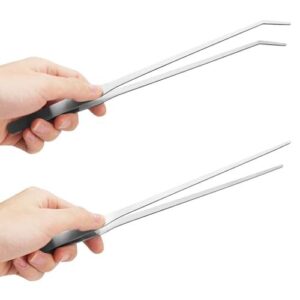
Maintaining precision during tank maintenance becomes effortless with long stainless steel tweezers. These 10.6-inch tools keep your hands safely away from defensive snakes while allowing accurate placement of decorations and substrate adjustments.
The serrated tips grip securely, preventing dropped items that could stress your snake. You’ll appreciate the curved option for maneuvering tight corners and the straight design for general cleaning tasks.
Clean with warm soapy water after each use, then disinfect weekly with F10SC solution to prevent cross-contamination between enclosures, ensuring a safe and healthy environment for your snake with proper maintenance.
Best For: Snake owners and aquarium enthusiasts who need precise, safe tools for tank maintenance, feeding, and decoration placement without risking bites or getting hands wet.
- Long 10.6-inch reach keeps hands safely away from defensive animals while maintaining precise control
- Durable stainless steel construction with serrated tips provides secure grip and corrosion resistance
- Dual-purpose set includes both straight and curved options for versatile cleaning and feeding tasks
- Slightly heavier than standard feeding tongs, which may cause hand fatigue during extended use
- Requires regular disinfection and careful drying to prevent rust formation in humid environments
- Higher initial cost compared to basic plastic alternatives, though justified by durability and safety
6. Natural Coral Driftwood Aquarium Decor
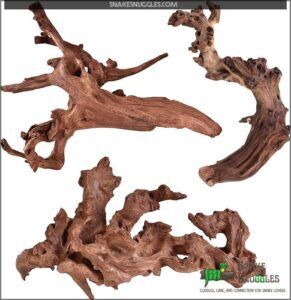
Natural coral driftwood transforms your snake’s enclosure into a mesmerizing underwater forest scene while providing essential climbing structures.
Before introducing this porous decoration, you’ll need to boil it for 1-2 hours to eliminate harmful bacteria and parasites lurking in those tiny crevices.
After boiling, soak the wood completely submerged for 1-2 weeks, changing water when it darkens from tannin release.
This thorough preparation prevents your snake from encountering nasty microbes that could cause serious health issues.
Best For: Reptile owners seeking natural climbing structures and aquarium enthusiasts wanting authentic-looking decor that creates realistic underwater forest environments.
- Provides essential climbing enrichment for reptiles while creating stunning natural aesthetics in aquariums and terrariums
- Releases beneficial tannins that soften water and lower pH, replicating natural tropical habitats many species prefer
- Offers natural shelter and hiding spots that reduce animal stress while supporting beneficial biofilm growth for ecosystem health
- Requires extensive preparation including 1-2 hours of boiling and weeks of soaking to eliminate harmful bacteria and parasites
- Natural variations mean you can’t predict exact size, shape, or quality, leading to potential disappointment with purchases
- May cause water discoloration from tannin release and requires ongoing maintenance to prevent mold or excessive degradation
7. Snake Climbing Enrichment Toy for Reptiles
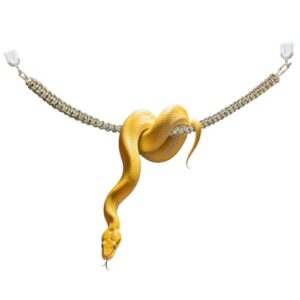
Paracord climbing ropes transform your snake’s enclosure into an active playground.
This 24.4-inch woven rope promotes muscle development and coordination while reducing obesity through increased physical activity.
The durable material resists fading and supports strong load-bearing capacity.
Installation is straightforward with included adhesive hooks and suction cups requiring no tools.
Clean the rope weekly using F10SC disinfectant diluted at 1:250 ratio or steam cleaning above 200°F.
Allow complete drying before returning to the enclosure to prevent bacterial growth.
Best For: Snake owners looking to encourage natural climbing behaviors and physical activity in species like hognoses, corn snakes, milk snakes, and pythons.
- Promotes muscle development and coordination while reducing obesity through increased physical activity and exercise
- Durable paracord construction with fade resistance and strong load-bearing capacity ensures long-lasting use
- Simple tool-free installation with included adhesive hooks and suction cups for easy setup and removal
- Requires weekly cleaning with specialized disinfectant or steam cleaning above 200°F for proper maintenance
- May not be suitable for larger python species that could exceed the rope’s load-bearing capacity
- Limited to 24.4-inch length which may not provide adequate climbing space for larger enclosures
8. Mini Digital Hygrometer Thermometer 2 Pack
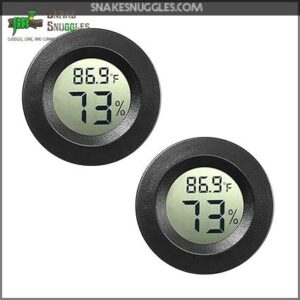
These digital monitoring devices keep tabs on your snake’s environment with temperature accuracy of ±1°F and humidity readings within ±5%RH.
You’ll get readings updated every 10 seconds through 24 sensitive vents, making environmental adjustments a breeze.
Position them away from direct heat sources and water dishes for accurate measurements.
Clean the outer shell with a damp cloth monthly, avoiding water entry into the sensor compartment.
The compact 1.78" design fits perfectly in tight spaces, and LR44 batteries last up to nine months before replacement.
Best For: Snake owners and reptile enthusiasts who need affordable, reliable environmental monitoring for terrariums and enclosures.
- Fast 10-second updates with ±1°F temperature accuracy ensure responsive environmental monitoring
- Compact 1.78" design fits easily in tight spaces while 9-month battery life reduces maintenance
- Dual temperature/humidity readings help maintain proper gradients for snake health and comfort
- ±5%RH humidity accuracy may be insufficient for species requiring precise moisture control
- Battery replacement requires removing sticky mounting pad, potentially affecting placement stability
- Quality control issues with some units arriving with dead batteries or displaying inconsistent readings
9. Snake Climbing Rings Reptile Enrichment
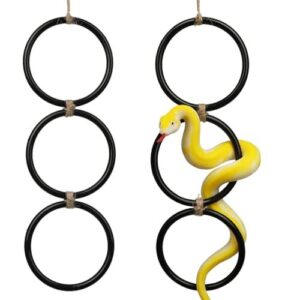
Snake climbing rings offer essential behavioral enrichment that transforms captive environments.
These interlocking ABS plastic rings create versatile 28-inch climbing pathways that encourage natural exploration and exercise.
Studies show 68% increased exploratory behavior in snakes using these structures.
The rounded 4.6-inch diameter prevents scale damage while supporting species up to five feet.
Clean rings weekly with F10SC disinfectant or mild soap solution.
Allow complete drying before reinstallation.
The modular design lets you customize difficulty levels, promoting muscle development and reducing stress-induced behaviors in your snake’s habitat.
Best For: Reptile keepers seeking proven enrichment solutions for semi-arboreal species like Ball Pythons, Corn Snakes, and Bearded Dragons who want to promote natural climbing behaviors and reduce stress.
- Research-backed results showing 68% increase in exploratory behavior and 42% reduction in stress-induced fasting
- Durable modular design with smooth ABS plastic construction that prevents scale damage while creating customizable 28-inch pathways
- Strong sustainability commitment including rainforest conservation, rescue donations, and lifetime upgrade program
- Limited to species under 5 feet in length, excluding larger snakes and adult boa constrictors
- Requires secure mesh lid attachment system that may not work with all terrarium types
- Weekly cleaning maintenance required with specific disinfectants to prevent bacterial buildup
Cleaning Frequency and Tips
You’ll need a consistent cleaning schedule to maintain your snake’s health and prevent dangerous bacterial infections.
Daily spot cleaning removes waste and debris, while weekly deep cleaning of all accessories guarantees your pet stays comfortable and disease-free.
Daily Cleaning Tasks
Maintaining your snake’s habitat requires consistent daily attention to prevent health issues.
Start with spot cleaning by removing any visible waste and uneaten food residue immediately. Check water dishes for contamination and perform water changes as needed.
Conduct a quick visual inspection of hides and decorations for debris. These simple snake tank cleaning tasks take minutes but protect your reptile from bacterial infections and maintain ideal living conditions.
Weekly Cleaning Schedule
Weekly snake tank cleaning keeps your reptile healthy and stress-free.
Remove all accessories for thorough handwashing with reptile-safe cleaners to eliminate bacteria and fungi.
Spot cleaning waste removal prevents buildup, while water changes guarantee fresh hydration.
Assess condition of substrate and replace soiled areas to maintain prime habitat conditions and prevent respiratory infections.
Deep Cleaning Techniques
Monthly deep sanitization requires thorough snake tank sanitization beyond regular maintenance. Soaking Accessories in F10SC solution for 30 minutes eliminates stubborn pathogens. Boiling Wood decorations for 20 minutes sterilizes porous materials effectively. Baking Stone hides at 200°F for one hour provides chemical-free disinfection. Steam Duration of 10-15 minutes kills cryptosporidium and other resistant organisms.
Complete Residue Removal guarantees your snake’s safety after deep cleaning sessions.
- Disassemble all snake tank decor for individual cleaning access
- Use steam cleaning for snake tank accessories maintenance when possible
- Allow 24-hour drying time before reassembling cleaned components
- Document cleaning dates for snake tank accessories cleaning schedules
Maintaining Humidity and Temperature
Maintaining proper humidity and temperature during cleaning requires careful monitoring to prevent stress-induced health issues in your snake.
You’ll need to quickly restore ideal conditions after cleaning accessories, as even brief environmental changes can disrupt your snake’s thermoregulation and respiratory function.
Using Hygrometers and Thermometers
Two digital thermometer and hygrometer units provide accurate readings when placed at opposite tank ends.
Calibration needs attention every six months for precision. Digital vs analog devices? Digital wins for clarity and trend monitoring.
Placement matters—position sensors away from heat sources for true environmental data.
Monitor daily humidity and temperature patterns to catch fluctuations early. Consider using a digital humidity reader for best results to ensure accurate readings.
Creating a Temperature Gradient
Proper thermogradient setup requires strategic heat source placement and thermostat use.
Position your basking spot temp at 90-95°F while maintaining cool side range between 75-85°F.
Different heat source types—ceramic emitters, heat pads, or lamps—create this essential temperature control gradient.
Your snake’s species temperature needs determine exact ranges, but consistent heating systems guarantee healthy thermoregulation throughout the snake enclosure temperature zones.
Humid Hide Maintenance
Maintaining your humid hide transforms a simple accessory into a thriving microhabitat that supports healthy shedding cycles.
This specialized environment requires consistent attention to prevent harmful bacteria buildup while ensuring ideal reptile hide safety and wellbeing. Consider using quality sphagnum moss for superior humidity retention.
- Moss Renewal: Replace sphagnum moss weekly or when odors develop to maintain humidity control
- Mold Prevention: Check daily for condensation buildup and adjust ventilation accordingly
- Hiding Security: Disinfect hide structure bi-weekly using reptile hide cleaning protocols
- Material Degradation: Monitor plastic components for cracks that harbor bacteria during reptile hide maintenance
Preventing Stress During Cleaning
Cleaning your snake’s habitat doesn’t have to stress out your scaly friend if you time it right and work efficiently.
You’ll want to clean when your snake is least active and provide temporary shelter during the process to minimize disruption to their routine, ensuring a smooth experience for your scaly friend.
Minimizing Handling and Disturbance
When snake enclosure cleaning begins, your approach determines your pet’s stress levels.
Gentle Removal of accessories prevents sudden movements that trigger defensive responses.
Practice Minimal Contact by removing only necessary items during each session.
Create a Quiet Environment by avoiding loud noises or rapid movements.
Snake scent sensitivity means they’ll detect cleaning product residues, so guarantee thorough rinsing.
After cleaning, allow Gradual Introduction of items back into the habitat.
Establish an Observation Post-Clean routine to monitor behavioral changes.
Effective snake handling during maintenance protects both you and your reptile from unnecessary anxiety.
Snake stress reduction starts with thoughtful cleaning practices, ensuring a safe and healthy environment for your pet, through Effective handling and care.
Providing a Safe Environment
Creating a secure sanctuary during snake tank cleaning requires strategic preparation and Safe Disinfectant Use protocols.
You’ll maintain ideal conditions while protecting your snake from Accessory Material Risks through systematic safety measures.
- Prepare temporary housing with proper ventilation and familiar substrate before starting snake tank cleaning procedures
- Monitor temperature stability using backup heating elements to prevent thermal shock during reptile cleaning products application
- Ensure adequate ventilation when using snake enclosure cleaning products to eliminate harmful chemical residues
- Practice Gentle Handling techniques during transfers to minimize stress responses and defensive behaviors
- Maintain Hygiene Importance standards by disinfecting all transfer containers and tools before reptile accessories safety protocols
To prevent bacterial issues, consider daily spot cleaning of the enclosure.
Common Mistakes to Avoid
Even experienced reptile keepers can make critical errors that jeopardize their snake’s health and well-being.
Understanding these common pitfalls helps you maintain a safe environment while avoiding costly mistakes that could harm your pet, ensuring a clean space for your reptile.
Using Toxic Cleaning Agents
Ammonia-based cleaners and bleach create toxic fumes that cause respiratory distress and fume inhalation risks.
These harsh chemicals leave dangerous residue that triggers skin irritation in sensitive reptiles. Species sensitivity varies, but all snakes suffer from chemical exposure.
Choose safe alternatives like F10SC or chlorhexidine for reptile accessories safety. To guarantee the safety and effectiveness of disinfectants, remember the importance of proper dilution.
Avoid reptile accessories toxicity by selecting products specifically designed for snake tank accessories safety over household cleaners.
Inadequate Cleaning and Maintenance
Over time, sporadic cleaning creates a breeding ground for trouble.
Disease Prevention becomes impossible when bacteria flourish in dirty water dishes and neglected hides.
Poor Odor Control signals underlying problems, while Mold Growth thrives in damp substrates left too long.
Mite Infestations spread rapidly through contaminated reptile accessories cleaning schedules, and Scale Rot develops when reptile terrarium cleaning falls behind, making your snake’s health suffer needlessly.
Disregarding Species-Specific Needs
Beyond poor cleaning practices, overlooking species-specific requirements creates serious health risks.
Each snake species demands customized husbandry that affects cleaning protocols and accessory maintenance.
- Humidity Requirements: Ball pythons need 60-80% humidity while corn snakes thrive at 40-50%
- Temperature Gradients: Arboreal species require different basking zones than terrestrial snakes
- Substrate Selection: Burrowing species need deeper substrates that require specialized cleaning approaches
- Enclosure Size: Larger species need bigger snake tank accessories and more frequent cleaning disinfection
- Enrichment Needs: Climbing structures for arboreal species collect debris differently than ground-level hides
Frequently Asked Questions (FAQs)
How to clean snake enclosure accessories?
Like scrubbing bacteria from surgical instruments, you’ll disinfect accessories using F10SC at 1:250 dilution or steam cleaning above 200°F.
Remove your snake first, then soak accessories in disinfectant, rinse thoroughly, and air-dry completely.
What is the best cleaner for snake tanks?
F10SC veterinary disinfectant stands out as the gold standard for snake tanks.
You’ll dilute it 1:250 for routine cleaning.
It’s non-toxic when dry, kills everything nasty, and won’t stress your snake.
How often should you clean a snake tank?
Maintaining your snake’s habitat like clockwork promotes maximal health. Spot-clean waste immediately, deep-clean monthly using F10SC disinfectant, and replace substrate every 4-6 weeks depending on bioactivity and species requirements.
How often should water dishes be replaced?
You should replace your snake’s water dish every 3-5 days or immediately when it becomes soiled. Fresh water prevents bacterial growth and keeps your snake healthy and hydrated.
Can I use dish soap on accessories?
Dish soap contains residues harmful to snakes’ sensitive respiratory systems.
You’ll want F10SC disinfectant or vinegar solutions instead – they’re proven safe when properly rinsed and won’t compromise your snake’s health like detergents can.
What temperature kills harmful bacteria and parasites?
Heat above 200°F kills most harmful bacteria and parasites in snake accessories. Steam cleaning at this temperature effectively eliminates pathogens including tough organisms like cryptosporidium without chemicals.
Should I clean accessories while snake watches?
Looking at this from a behavioral perspective, you shouldn’t clean accessories while your snake watches.
Snakes experience stress from environmental disruption and unfamiliar activities.
Remove your snake to a temporary secure container first, then clean accessories thoroughly with appropriate disinfectants before returning everything to normal.
How long should disinfectants sit before rinsing?
F10SC needs 10 minutes contact time, while chlorhexidine requires 5-10 minutes. Bleach solutions work in 1-5 minutes. You’ll want longer contact times for tougher pathogens like cryptosporidium.
Conclusion
Remarkably, the same thorough approach veterinarians use to sterilize surgical instruments applies perfectly to cleaning snake tank accessories.
You’ve learned that regular maintenance using veterinary-grade disinfectants prevents dangerous bacterial infections that develop within 48-72 hours.
Steam cleaning, proper rinsing, and weekly deep cleaning schedules keep your snake healthy.
Remember to avoid toxic household cleaners and focus on high-contact items like water dishes and hiding spots.
Proper cleaning snake tank accessories isn’t just maintenance—it’s essential healthcare for your reptile companion, and it involves a thorough approach to prevent infections and keep your snake healthy.
- https://www.zenhabitats.com/blogs/reptile-care-sheets-resources/reptile-safe-disinfectant-cleaners
- https://www.oxyfresh.com/blogs/pet-health/snake-terrariums-101-your-guide-to-safe-cleaners
- https://www.tampavet.com/exotics-blog/cleaning-reptiles-habitat/
- https://faq.dubiaroaches.com/articles/reptile-safe-cleaning-and-disinfecting-agents
- https://www.thebugshed.com/cleaners-for-reptile-enclosures/

